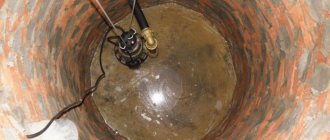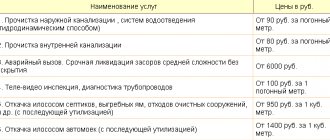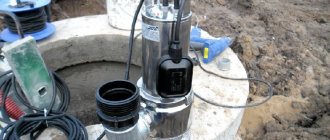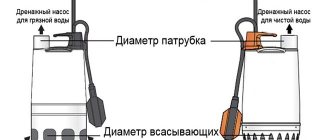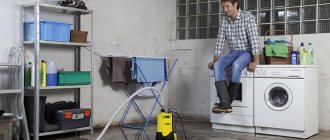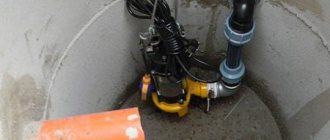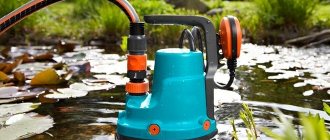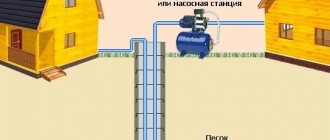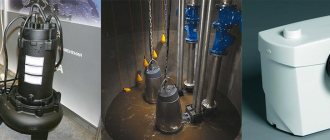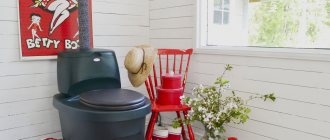Drainage and fecal - what's the difference?
There are two types of pumps for pumping wastewater: drainage and fecal. What is the difference? Drainage systems are designed to drain contaminated water containing small solids - silt, sand and other substances of approximately the same size. To prevent larger particles from getting inside, install nets. As can be seen from the description, drainage pumps are suitable for pumping clarified water from a storage well located after a septic tank, for pumping water from a storage well for drainage and storm sewers.
A sewage pump differs from a drainage pump in that it can pump viscous media with fairly large solid particles
If you need to pump out sludge from an automatic individual cleaning unit (such as Topas or others), or sediment from the bottom of a septic tank, a drainage system cannot cope with this. The medium is too thick. For a septic tank, in principle, there is a way out: stir up the sediment, pump out the suspension, add water again, shake up again and pump out again. This can be done, but the septic tank will then take a very long time to reach operating mode, so this method can only be used in extreme cases. It is better to purchase special equipment that can handle compressed sediment.
Sewage pumps are used to clean cesspools and septic tanks. They can pump highly contaminated liquids, viscous media that may contain solid particles. The particle size depends on the model, but the maximum size is 50 mm. It is not always the case that all waste in a cesspool rots to such a state. To cope with the situation, a chopper is installed at the bottom of the pump. It is usually installed on centrifugal models - additional cutting blades are installed on the shaft. The already crushed wastewater enters the working body of the pump.
So if you plan to use a fecal pump to pump out a cesspool, it is advisable that the model include a grinder. It grinds larger particles to acceptable sizes.
Types of fecal pumps
Sewage pumps operate in an aggressive, chemically active environment. In addition to the fact that their body must be sealed, the materials from which it is made must be chemically neutral and resistant to aggressive environments. There are very few such materials:
- stainless steel;
- some types of plastic;
- cast iron.
The best material is stainless steel, but this material is also the most expensive. The most budget option is a plastic case. These models are the cheapest. In the middle price category there are fecal pumps for pumping out sewage with a cast iron body. Despite the fact that you rarely use this device, you should not choose cheap models. Perhaps for a dacha where you come only from time to time.
This is all a submersible sewage pump with a grinder
By type of installation, pumps for pumping out feces are:
- Submersible. They are installed at the bottom of the tank and usually operate in automatic mode. Switching on/off occurs using a float switch. The float rises/falls along with the liquid level; when it is at the bottom, the pump is turned off.
- Semi-submersible. These pumps are elongated, their suction part is located quite far from the motor. The motor remains on the surface, it floats on a special platform, the suction part is located in the thickness.
- Superficial. Only the hose connected to the inlet pipe is lowered into the tank; the device itself is located next to the tank. A surface sewer pump usually has a plastic body and low capacity. This is basically a country option.
Now we need to figure out all this diversity - when and which devices are best to use.
Types of sewer electric pumps
Sewage pumps are divided into indoor and outdoor installations. The first models are chosen for installation near toilets and sinks. They are designed for forced pumping of wastewater through sewer pipes to a septic tank.
Such units can be designed to connect one or several plumbing fixtures at once. The second category of sewer pumps is more familiar and they are the ones most often purchased for summer cottages.
Depending on the design features and installation method, all models of fecal hydraulic pumps are divided into three groups: surface, submersible and semi-submersible
Fecal, drinking water and drainage pumps should be clearly separated. The first ones are initially designed for grinding solid feces and small debris.
The second and third are intended for pumping water that is only clean or has fine suspended matter. If a rag or food debris gets into them, these electric pumps will simply break down.
Group #1: surface aggregates
Surface pumps for feces provide a dry installation method. To operate in automatic mode, they are mounted next to the storage manifold or in a manhole. In fact, it is a small pumping station made up of several separate parts.
At the dacha, a surface pump for dirty water is most often used in a portable version; it is assembled and turned on as needed, and then put back into the utility room
This type of hydraulic pumps for sewerage is the easiest to maintain and operate. At the dacha itself, it is installed next to a cesspool or drainage pit, and a hose connected to it is immersed in the fecal matter.
When choosing this pump, special attention should be paid to the maximum possible suction depth. The passport usually indicates 8–10 meters. If the hole is deeper, then this pump will not be able to lift wastewater from it.
But here it is necessary to take into account not only the size of the reservoir from which water is pumped, but also the distance from it to the pumping equipment. Each horizontal meter of hose reduces the depth capabilities of the unit by 10 cm.
Low-power models are a compact unit and for short-term operation are installed on the floor or ground next to the waste tank
More powerful installations require a stable platform. They are mainly installed indoors, where such a platform can be easily and securely fixed to the floor.
The main disadvantage of a surface sewage pump is that it cannot operate in a damp environment. Only the suction hose can be in the water; the unit body must be on the ground and in a dry place.
It is allowed to operate such a pump only in rainy weather, and it is better to erect a small canopy for it, otherwise moisture will get inside the housing, which will inevitably lead to a short circuit.
Surface models are cheap and easy to maintain, but are quite noisy. If the pump is selected for installation in a utility room or basement, then this is the best option. But for working outside and pumping feces from a septic tank located far from a country house and buildings, it is better to purchase a submersible analogue.
Group #2: Semi-submersible kits
Semi-submersible pumping equipment consists of an electric motor installed in a dry place and a working chamber immersed in drains. They are connected into a single whole by a torque shaft.
At dachas and in general in domestic conditions, semi-submersible pumps are rare; they are complex in design and operation - they are mainly chosen for industrial-level pumping stations
If a semi-submersible hydraulic pump is purchased for a summer residence, then it can be mounted by:
- fastenings on the wall of the drainage pit;
- installation on a platform floating on drains;
- installation in an extension next to the storage tank.
Another potential problem with the semi-submersible model is the lack of a grinder included as standard. And without it, the pump will quickly fail when pumping garbage and feces from the sewer system.
The chopper is installed additionally on such an installation, in the form of an attachment. And this increases the cost of equipment and complicates its maintenance.
Group #3: submersible hydraulic pumps
This modification of country sewage pumps involves directly immersing the entire unit in a pit with wastewater. And so that the installation does not break down in an aggressive and active sewage environment, its sealed body and all working parts are made of cast iron or stainless steel.
There are models on sale with a plastic casing, but it will not last long in the sewer. Submersible equipment for pumping feces can be used both for one-time work and in automatic mode.
In the second case, the sewage pump for the dacha should be selected with a float and automation. When the specified level of liquid in the waste tank is reached, the pumping equipment is first turned on, and then, as sewage is pumped out, it is turned off by a float device.
The submersible sewage pump is installed directly on the bottom of the drainage pit or suspended at a height of 10–20 cm above it (+)
The presence of a float prevents the pumping equipment from running dry, which significantly prolongs its life. Submersible pumps are chosen by those who require productive and reliable equipment.
Many similar models are equipped with a built-in chopper. It stands at the input and grinds all incoming waste to a state in which it simply cannot lead to breakdown of internal mechanisms.
Compared to a surface-mounted competitor, the submersible pump is less noisy and consumes less electricity. All its power is spent on maintaining pressure in the pressure outlet pipe. It also does not have to waste energy on sucking wastewater from the bottom into the working chamber through a hose.
When a submersible unit operates, water absorbs most of the noise generated by the electric motor. But the unit is more difficult to operate and costs more than a surface model of similar power. Equipment immersed in sewage drains is initially more technologically advanced and complex than equipment left in the air.
Features of operation and installation
When choosing a fecal pump for sewage, you must first of all be based on the operating conditions of the equipment. If you are selecting equipment for a summer residence, there is no need to spend money on expensive and powerful submersible models. For these purposes, small and mobile surface installations are optimal. They are good because you can take them with you for the winter - they weigh 5-12 kg, depending on the power. If you are selecting equipment for a private permanent home, it makes sense to purchase more expensive equipment that can be installed permanently.
Submersible sewage pump
This equipment can be installed permanently or mobile. For a stationary installation, a platform is made at the bottom to which the housing is attached. Pipes (usually plastic) are connected to the outlet pipe. The option is not bad, but if the need for repair or maintenance arises, it is not clear how to get the unit.
Installation options for a submersible sewage pump
How to install a submersible sewage pump yourself
The pipe coming from the pump can be led up to the surface of the earth, or it can be led into the wall and laid, say, a pipeline underground to a storage tank. This is an option for those who cannot reach their septic tank/cesspool with a regular sewage disposal truck. In this case, you need to call a special machine with a long hose. But a couple of these calls are equal to the cost of a mid-priced sump pump. Therefore, often in such cases, a storage tank is built/installed in accessible places, the residues are pumped into it using a fecal pump, and then a regular machine is called.
What it might look like when finished
The second, mobile option is better in this regard. Two rods are mounted along one of the walls of the tank. The diameter is slightly smaller than the diameter of the holes in the housing. A chain is attached to the top of the submersible sewer pump, and a corrugated pipe is connected to the outlet pipe. Next, the body is put on the installed rods, and the device is lowered to the bottom, as if on rails. With this installation method, if necessary, the pump is pulled out by the chain. There is only one drawback - the need to use corrugated pipes. Their structure leads to the fact that the pipes often become clogged; accordingly, they need to be replaced, since cleaning them is very unpleasant.
Installation options for submersible pumps for septic tank sewage, drainage and storage wells
You can avoid using a corrugated hose in models with a lower suction pipe. In this case, a rigid (plastic) pipe is mounted, its end is brought out so that the pump descending along the guides fits onto it (pictured on the right).
And the easiest installation option: simply lower the device to the bottom on a chain. When the wastewater is pumped out to the required level, the equipment is turned off and removed from the tank, washed, dried and taken to the utility room until next use.
| Name | Power | Lift height/pressure | Performance | Notes | Price |
| Grundfos SEG 40.12.2.1.502 | 1200 W | 20.5 m | 18 m3/h | Cable length 10 m, chopper | 1025$ |
| Ebara Right 75 M/A | 500 W | 8.6 m | 14 m3/h | Permissible diameter of solid inclusions 35 mm | 250$ |
| Speroni SEM 150-VS | 1700 W | 11 m | 24 m3/h | Float switch, chopper | 560$ |
| Homa Barracuda GRP 16 BD | 900 W | 20 m | 18.7 m3/h | Chopper | 1160$ |
| Ebara DW M 150 A | 1600 W | 16 m | 42 m3/h | Permissible diameter of solids 50 mm, float switch | 620$ |
| Speroni CUTTY 150/N | 1500 W | 17 m | 21 m3/h | Chopper | 770$ |
| Irtysh PFS 50/125.120 | 1100 W | 6 m | 16 m3/h | Float switch | |
| Irtysh PFS 50/125. 98 | 1100 W | 4 m | 7 m3/h | Float switch | |
| Irtysh PF2 50/140.138 | 3000 W | 22 m | 25 m3/h | Float switch | |
| Gilex Fekalnik 150/7N 5302 | 550 W | 7 m | 9 m3/h | Allowable diameter of solids 35 mm, float switch | 105$ |
| Gilex Fekalnik 200/10 F 5301 | 880 W | 10 m | 12 m3/h | Allowable diameter of solids 35 mm, float switch | 70$ |
| Gilex Fekalnik 255/11 N 5303 | 1100 W | 11 m | 15 m3/h | Allowable diameter of solids 35 mm, float switch | 125$ |
Despite the rather complex installation, submersible sewage pumps are the most popular. This is explained by the fact that they are usually more powerful, and they can also pump media with particles up to 50 mm in size. And it is submersible models that can be equipped with a chopper.
Advantages of submersible pumps:
- They can lift liquid from great depths.
- It can operate in automatic mode, using a float to control the liquid level.
- There is no need to worry about cooling.
- Low noise level.
It is submersible fecal pumps that can develop sufficient power to pump out contents from great depths. In the case of sewerage, this may not be so important - septic tanks are not so deep. But, if necessary, you can pump wastewater over a long distance over the surface. The main thing is that there are enough hoses.
Semi-submersible models of fecal pumps
This type of equipment combines the advantages of surface and submersible pumps. Since the engine is above the surface of the water, there is no need to waterproof it perfectly. There is also no need to tightly arrange all the parts in the case. All this has a positive effect on the price - it is significantly lower than submersible models.
The disadvantage of fecal semi-submersible pumps is the smaller particle size that it can absorb and the smaller depths at which it can operate. Another disadvantage is that a grinder cannot be installed on this type of pump. However, not all disadvantages are significant for domestic use. Too great depths are not needed for private use, and a simpler design makes repairs more accessible, so there are clearly more advantages.
One of the types of semi-submersible devices is vertical
A feature of installing semi-submersible pumps is that it must be installed so that the motor is above the water. The installation method depends on the model; it is specified in the product instructions. In general, there are several installation methods:
- They make a platform on the wall of the tank, and attach the equipment to it. With this installation method, you must ensure that the liquid level does not rise above the platform - the upper part of the housing is not sealed. You can control the level using automation - sensors that send a signal to turn it on and off.
- Installation on a floating pad. This installation method is used for small semi-submersible sewage or drainage pumps for domestic use.
- Very small models, also called “barrel” models, can be hung on board.
Despite all the advantages, this model is not used so often. Basically, a sewage pump is purchased as a submersible or surface type.
| Name/manufacturer | Power | Lift/pressure | Feed/capacity | Notes | Price |
| FGP 20/10 (L=1.3 m) | 2.2 kW | 10 m | 20 m3/hour | Maximum particle size 15 mm | 400$ |
| NCI-F100 | 0.5 kW | 8 m | 100 m3/hour | Centrifugal with chopper | 1525$ |
| FGS50-12.5 | 4 kW | 12.5 m | 50 m3/hour | Maximum particle size 15 mm | 760$ |
| FGS30-10 | 2.2 kW | 10 m | 30 m3/hour | Maximum particle size 15 mm | 515$ |
Product marking
It is applied to identify the specimen as belonging to a particular model. In this case, the name and main technical characteristics are indicated on the plate.
The installation of such plates on the body is intended to facilitate identification when choosing a product, and with an initial familiarization with the technical characteristics of the product.
Popular manufacturers of fecal pumps
As noted above, fecal pumps are produced by many manufacturers. The most popular of them are:
- Pumps manufactured by Pedrollo . Used for pumping heavily contaminated wastewater. The most popular equipment lines are VXm MC/MCm. The first of them, less powerful, operate on a 220 volt network and have a minimum power of 0.6 kW. They are the most popular for use in fecal sewers in private homes. The permissible size of solid inclusions is 35 millimeters. Main technical characteristics:
- engine voltage – 220 or 380 volts;
- maximum emptying rates from the bottom are 40-55 millimeters;
- working pressure from 15 to 66 liters per hour;
- immersion depth indicators - 8-22 meters;
- the diameter of the outlet pipe is 1.5-2.5 inches.
- Grundfos SEG sewage pump . The unit is equipped with a grinder and is designed for pumping sewage, drainage water, and wastewater. It is capable of pumping wastewater over considerable distances, but the pipe size is limited to 40 millimeters.
Main characteristics of the equipment:
- body material – cast iron;
- the pump is equipped with an impeller adjustment system;
- 2 relays are installed to protect the device from overheating;
- used for pumping to a depth of 10 meters;
- the maximum permissible temperature of the pumped liquid is 40 degrees.
- Sewage pumps Gillex . The company produces two types of pumps – Fekalnik and Drainazhnik, the names of which indicate their purpose. The acceptable size of solid inclusions is 35 millimeters. Main technical characteristics:
- productivity 160-260 liters per hour;
- immersion depth – 6-11 meters;
- installation of a float switch.
- Sulzer – pumps for pressure sewerage. Strictly speaking, this is a station for pumping fecal wastewater with its simultaneous processing to a liquid state. Its advantage is quick installation and startup. The station is equipped with a reliable check valve and a powerful solids grinder.
Vortex
fecal pump is designed for pumping wastewater with strong fibrous contaminants.
Used for domestic purposes. Main technical characteristics:
- power 450-1500 watts;
- pressure 9-18 meters;
- productivity 16-24 cubic meters per hour;
- solid inclusions of 15-42 millimeters are allowed;
- permissible liquid temperature is 40 degrees.
A pump for forced sewerage in a private house in some cases is a forced solution, depending on the landscape of the area in the development region.
Installation of a fecal pump
Installing a sewage pump is a responsible undertaking, on which comfortable and safe living in a private home depends. This in itself is not such a difficult undertaking and can be done independently.
But the stable and correct operation of this system is extremely important. Therefore, it is better to entrust its installation, especially in difficult cases, to specialists. But this does not mean that you do not need to have knowledge of how it works in order to carry out qualified installation control.
Surface Models
The easiest installation is for surface-type sewage pumps. The device itself is placed on the ground, and only the hoses are lowered into the container.
Surface models of fecal or drainage pumps are attractive for their mobility
The most serious drawback of such models is the phenomenon of cavitation, which occurs when pumping liquids from great depths. Cavitation is the saturation of the pumped medium with air bubbles. If such a mass gets into the working part of the pump, it will fail. This is why it is not recommended to use surface fecal pumps at depths greater than those for which they are intended. In the case of pumping a septic tank or storage well, the use of such models is justified. Their depth is small, and even not the most powerful motor will cope with the task. You just need to choose the right power of the unit.
| Name | Type | Power | Lift/pressure | Performance | Notes | Price |
| Caliber NBC-380 | self-priming | 380 W | 25 m | 28 l/min | No idle protection | 30-35$ |
| Whirlwind PN-370 | self-priming | 370 W | 30 m | 45 l/min | No idle protection | 38-42$ |
| Gilex Jumbo 60/35 N | self-priming | 600 W | 35 m | 60 l/min | No idle protection, maximum particle size 0.8 mm | 104$ |
| Gilex Jumbo 70/50 P 3701 with ejector | self-priming | 1100 W | 50 m | No idle protection, maximum particle size 0.8 mm | 115$ |
Please note that all surface pump models are designed to pump water. Only some of them can pump viscous liquids, and this must be indicated in the description or data sheet. The disadvantage of this equipment is that it requires a homogeneous environment - the maximum particle size that they are able to pump is 0.8 m. The price is undoubtedly attractive, but among submersible models there are very inexpensive ones - for example, Gilex and Ebara. The latter also have a stainless steel body and a wide range of models with different pressure and performance.
TOP 10 best submersible sewage pumps
A fecal pump is a device for regular use, especially in the warm season. And when thinking about purchasing it, it is important to choose a model that will not only be powerful, but also durable, reliable in operation, and will serve its owner for many years. We present a rating of the most effective devices for pumping out local sewage in terms of price-quality ratio, according to users.
JILEX Fekalnik 230/8
The most inexpensive fecal submersible pump in our rating. Its power of 590 W is quite enough to clean sewage tanks built in suburban areas. It can also be used as a device for extracting dirty water from trenches and pits on construction sites, as well as from not very clean reservoirs for watering plants in the local area - vegetable gardens, flower beds, flower beds, trees, shrubs.
The device is designed for connection to a single-phase network. Its body is made of durable shockproof plastic. The device can be submerged to a depth of up to 8 meters. Recommended temperature of pumped water is +1 – +35 degrees.
JILEX Fekalnik 230/8
- Low noise level.
- Compact sizes.
- Easy to use.
- Low price.
- Small throughput (13.8 cubic meters/hour).
CALIBER NPTs-1400U (AquaLine)
A small, easy-to-use device, characterized by an attractive appearance and high power. The pump is distinguished by a wide range of tasks. With its help, you can pump out not only waste from sewers, but also dirty water from various reservoirs - swimming pools, drainage pits, etc., as well as clean water necessary for domestic use.
The model is equipped with a stainless steel insert, which increases service life, resistance to breakage, and rapid wear in an aggressive environment. The device is intended for connection to a single-phase network. It is immersed in water to a depth of 7 meters and pumps it out to a height of up to 11 m. The pump is designed to draw liquid whose temperature does not exceed 35 degrees and does not fall below 0 degrees.
CALIBER NPTs-1400U
- High power.
- Good performance.
- Large inlets for liquid intake.
- Low cost.
- Not a very long network cable.
VORTEX FN-250
A simple and easy-to-use submersible fecal pump, suitable for a summer house or small house. It is designed to purify wastewater that, in addition to water, contains large waste and feces. However, it can also be used to collect water from any reservoirs or reservoirs.
Despite the very low power - only 250 V, the device is very efficient in operation. In an hour, it is capable of pumping up to 9 thousand liters of water, which is quite enough for domestic needs. Before turning on the device must be immersed in water to a depth of 9 meters. The maximum pressure is 7.5 meters.
VORTEX FN-250
- High quality build.
- Internal parts are made of stainless steel.
- Moderate cost.
- Any liquid can be pumped out.
- Short network cable (6 m).
- Capacity 9 cubic meters m/hour.
GILEX Fecal 330/12
A powerful pump is a submersible pump for fecal water, which is perfect for pumping out the cesspool of a private house. It attracts buyers with its moderate power consumption and compact size. The device is easy to connect and operate.
In a minute, the pump pumps up to 330 liters of liquid, including feces and other inclusions, the diameter of which does not exceed 35 mm. Before turning it on, it must be immersed to a depth of 8 meters. It can also work effectively under partial immersion. The device is equipped with dry-running protection.
GILEX Fecal 330/12
- Durable housing.
- High power (1200 W).
- Pumps out even very dirty water.
- Idling protection.
- No grinding knives.
PATRIOT FQ 500
A good fecal pump with a grinder, which is suitable for the toilet of a private house. It crushes large impurities, inclusions, and debris into small pieces that will not get stuck in the hose and will not damage the device itself.
The pump is installed at a depth of up to 7 m and is capable of pumping water to a height of up to 8.5 m. It is equipped with a comfortable handle that makes it easy to carry. The advanced particle shredding blade is designed to prevent objects from getting wrapped around it that could cause the engine to jam.
The housing is made of stainless steel and cast iron, which reliably protect the motor and other parts of the device from damage.
PATRIOT FQ 500
- Good chopping knife.
- High throughput.
- Durable housing.
- Good build quality and materials.
- Low pressure (8.5 m).
- The outlet nozzle is located close.
Sturm! WP9775SW
Reliable submersible pump for sewage water. With its help, you can pump out not only dirty water, but also thick liquid with impurities whose size does not exceed 35 mm, as well as grind larger debris. To do this, it must be immersed in water to a depth of 5 m.
The supply height of the pumped liquid is 11 m, which is very good at not the highest power - only 750 W. The length of the pump cord is 7.5 meters. The body is made of cast iron, which significantly increases its service life and reliably protects it from mechanical damage.
Sturm! WP9775SW
- Presence of a chopper.
- Durable cast iron body.
- Steel impeller
- Quiet operation.
- Heavy weight.
- The location of the knife from the liquid intake holes is large.
VORTEX FN-450
An easy-to-connect and manage model, characterized by low cost and reliable operation. It is suitable for both collecting water from reservoirs and pumping wastewater tanks where feces are collected. The pump is capable of removing liquid with fairly large impurities from cesspools.
In one minute, the device pumps about 267 liters of water and can supply it to a height of up to 12 m. It is equipped with a special sensor that detects the temperature of the liquid and turns off the motor if it exceeds the permissible level. This helps prevent the motor from overheating.
VORTEX FN-450
- High quality build.
- Pumps out even very dirty water.
- There is protection against dry running.
- Easy to use.
- Not very high power (450 W).
BISON NPF-1500-R
A powerful submersible sewage pump that will serve the owner for many years if used correctly. It pumps out equally well both clean water for domestic needs - washing, drinking, watering the garden, and dirty liquids - from the cellar, tank with feces.
The device is connected to a single-phase network - 220 V. Power consumption is 1500 W. In a minute, it is capable of pumping about 380 liters of water and delivering it to a height of up to 15 m. The body is made of stainless steel and cast iron, which significantly increases the durability of use, but also affects the weight of the device, making it heavier.
BISON NPF-1500-R
- High power (1500 W).
- Excellent pressure (15 m).
- Superior performance.
- Durable housing.
- Quite a lot of weight.
- Short cable (5 m).
BELAMOS DWP 1300CS
An excellent fecal submersible pump with a grinder, characterized by excellent performance and long service life. The presence of a special knife in the design allows it to be used not only for collecting clean water, but also for pumping out sewage pits, trenches, and tanks. It crushes large inclusions, thereby eliminating premature failure of the device.
The pump pumps out up to 300 liters of liquid per minute and is capable of delivering it under pressure up to 12 meters. Not only does the feces grinder allow you to increase its service life, but also the durable body made of cast iron.
BELAMOS DWP 1300CS
- Presence of a grinding mechanism.
- There is thermal protection.
- Durable cast iron body.
- High performance.
- High quality build.
- Cannot shred ropes or fabrics.
- Heavy weight (20.5 kg).
Pedrollo BCm 15/50
Efficient, powerful, expensive pump. However, its price is quite justified. A durable case made of stainless steel will protect the device from mechanical damage and premature failure. The large dimensions of the device allow you to pump out dirty water that contains inclusions with a diameter of up to 5 cm. All elements of the device are made of high-quality materials that can withstand exposure to liquids containing acids, alkalis, and detergents.
The water intake speed and pressure can be adjusted. In a minute, the pump can pump from 50 to 750 liters of liquid and discharge it to a height of 2 to 16 m. It can be used as a stationary or mobile device, depending on the wishes of the owner. For ease of carrying there is an ergonomic handle.
Pedrollo BCm 15/50
- High power (1100 W).
- Possibility to regulate the pressure and speed of pumping water.
- Convenient carrying handle.
- Availability of support for installation.
- High price.
- Heavy weight (34 kg).
How to calculate the required lift height
When choosing a fecal pump for sewage, you need to pay attention to two characteristics: its power (performance) and lifting height. With productivity, everything is more or less clear - it depends on the volumes that need to be pumped. The lifting height will have to be considered, because in addition to the vertical component, with which everything is clear (this is the depth of the well/septic tank from which the wastewater must be lifted), there is also a horizontal component - these wastewater must be transferred somewhere, usually into some kind of container. The distance over which the wastewater must be transferred in the horizontal plane is divided by 10. The result is added to the height of the rise from the well.
An example of technical characteristics of a fecal pump for pumping out sewerage
For example, the depth of a well is 4 meters, it is necessary to transfer waste water to 35 meters. Total we get: 4 m + 35 m / 10 = 7.5 m. The technical characteristics of the pump should include a lift height of at least this figure, or better yet 20-25% more, so that the equipment does not work at its limit, which leads to premature wear . Now you know how to calculate a sewage pump.
How to choose
When choosing the best option, you need to take into account that there are industrial and household models. The former are more powerful, stronger and much more expensive. The second ones are simpler and cheaper. For the needs of a private home, very productive installations are rarely required, however, different situations occur. In order of importance, the following selection criteria can be distinguished:
- technical characteristics - performance, power, lifting height, etc.;
- working conditions - chemical composition of the pulp, temperature, etc.;
- body material;
- the presence of a chopper in the design.
It is necessary to pay attention to the markings of the device. If there are no additional letters, it is intended for pumping liquids with a maximum solids value of 5 mm. If there is a letter “F”, the permissible size of inclusions reaches 35 mm. The presence of the letter “H” indicates the possibility of contact with aggressive pulp.
To select a specific model, you need to familiarize yourself with the parameters of installations from the most well-known manufacturers. To do this, you need to find online a review of pumps manufactured by companies from different parts of the world, and study the rating of the most successful and efficient devices. At the same time, it will be useful to consult with the seller in the store and listen to his recommendations, since information on the Internet is not always presented correctly and completely reliably. By comparing the technical characteristics and cost of the model, they find the best option, which they purchase for use in their home.
